SAN ANTONIO — San Antonio is preparing to deal with more migrants.
The city says unprecedented numbers of people are entering the country legally through the Alamo City.
On Thursday, city was reimbursed for their efforts in helping migrants reach their destination.
The city says since April 2021, over 185,000 migrants have passed through San Antonio. Right now the city is averaging nearly 600 migrants a day with 516 requiring overnight sheltering from March 19 to June 21.
That’s why the city is planning a new reception and processing center to allow the city to process the higher number of daily arrivals. Right now, migrants will arrive to Travis Park in downtown or San Antonio International Airport.
“It’s a very laborious effort to process these individuals and we’re doing that in Travis Park, outside 100-degree weather. So, this processing center allows us to centralize those operations in a more humane manner and be able to feed and provide that logistical support as well,” assistant city manager Lori Houston told KENS 5.
Some migrants may have to wait two to three days for a flight to their final destination.
This center which will provide food, shelter and transportation could cut down on congestion at those two locations.
“They are processed legally and allowed to travel in the United States legally, but they need help getting travel arrangements to their final destination,”
Houston says FEMA will be reimbursing the city over $12 million for this new center which could open by July and operate through December this year.
With Title 42 expected to end this fall, the city is expecting the migrant numbers to increase.
“We are being proactive in the event it is lifted,” Houston said.
The other half of the $25 million is being reimbursed for the city’s non-congregate sheltering. Two hotel facilities have been used since April 2020 to provide brief isolation for people who have been impacted by COVID-19, according to city documents.
Due to the decline of COVID-19 cases in San Antonio, less clients have needed sheltering. $12.6 million from FEMA will support the closeout of the local shelters, while the city will have to contribute 10% from its Health Implementation Plan.
“Now with the CDC guidelines decreased and relaxed, they’re allowed to go back to regular operation. But we have not had a massive COVID spread as a result of the homeless population, mainly because these measures were put into place,” Houston said.

